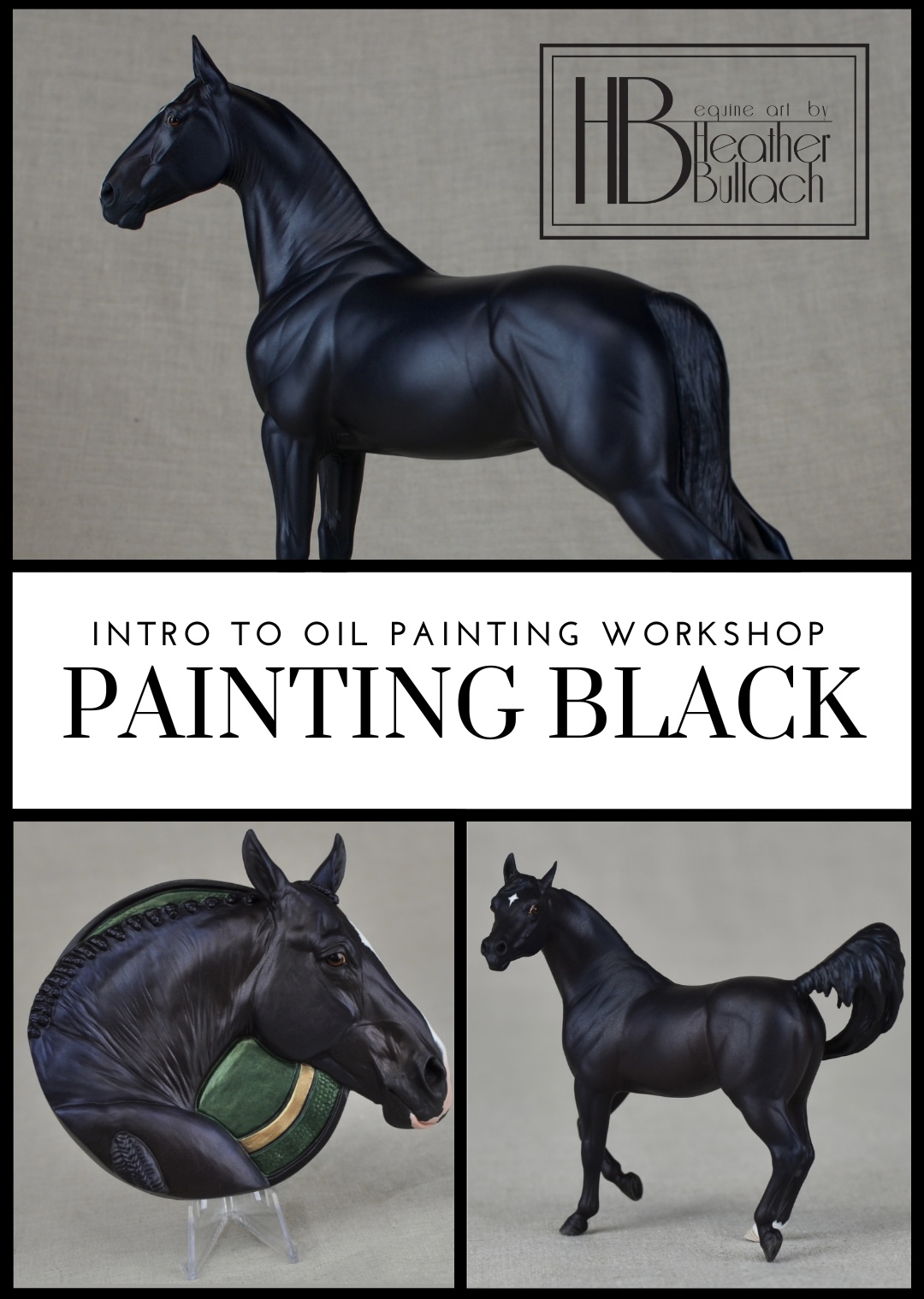Intro to Oil Painting Workshop: Painting Black
The class was offered in February 2023. Stay tuned for details on the February 2024 Painting Black workshop!
Join me this February on Zoom for a live workshop as we learn the basic techniques of painting a model with oils! This special edition of my intro workshop is simplified to allow more participants, with a much lower price point, a smaller supply list, and geared to be even more beginner friendly than my Bay and Chestnut intro course. We will still delve further into some more advanced techniques for more advanced painters. So all experience levels are welcome! In five sessions we will cover the basics of applying oil paint to a model, how to incorporate Pearl-ex pigments into oil painting, and how to apply final details with acrylics, all in hopes of completing a model from start to finish within the month of February!
Cost for 5 session course: $60 (or just $30 if you’ve already completed one of my courses!)
If button does not work, you may email me at [email protected]. Please include your name, your email for an invoice, and your email to receive the Zoom links (if different). You may wish to check your spam and add my email to your address book to avoid messages going to your spam folder.
Schedule
We will meet from 8:00-10:00pm EST on each of the following dates. Join live and ask questions as you paint, or watch the recorded session in your own time! Each session is recorded and available for rewatch the next day. Sessions will also be available for some time beyond the month of February if you would like to participate without the time constraint, or rewatch to paint another project!
Feb 1, Wednesday: Apply first layer of oils
Feb 6, Monday: Apply second layer, incorporate a bit of shading
Feb 13, Monday: Incorporate Pearl-Ex pigments
Feb 22, Wednesday: Acrylic details
Feb 28, Tuesday: Final paint party! Finish details
Oil painting supplies
For the course, you will need the following oils painting supplies. Read below for possible substitutions and eliminations.
•Oil paints: any brand you have should be fine. Colors are not necessarily interchangeable. I recommend the specific three colors on the list.
•Mediums: A good oil like refined linseed oils is a must. If you have another type you prefer you may interchange that. Galkyd is a drying medium. A drying medium is also a must, especially with blacks and especially with the challenge of completing a model in a month! You may use other dryers if you prefer such a cobalt dryer.
• Brushes: If you are doing a traditional or classic scale model, you could elimiate one or two of the smallest short handle brushes. You’ll want all three long handle brushes and at least two of the mop brushes.
If you are doing a venti/curio scale model or smaller, you could eliminate the #4 and #6 long handle brush, and maybe add a #4 short handle. One mop should be fine.
Pearl-Ex pigments: These two pigments are the two I use to achieve the shading on my black models. If you prefer a super simple paint project, you can use just black oil paint to create an even black finish and eliminate the pearl-ex pigments.
Palette Knife: A must for mixing oil paints!
Supplies you’ll need from home, or from your local stores:
•Paper towels I strongly recommend blue Shop Towels as they are lint free, found in local auto stores or supermarkets.
•Tinfoil to use as your palette (or, whatever palette you prefer to use)
•Murphy’s oil soap and an empty jar (you may also use a brush cleaner such as Master’s, or even just dishsoap)
•X-acto knife (or carbide scraper if possible)
•Rubber gloves for cleaning brushes
•Sealer of your choice. I prefer Testor’s dull coat.
Additional supplies for acrylic detailing
For adding acrylic detailing you’ll also want a selection of acrylics and separate acrylic brushes.
•Colors: Must have colors are Titanium white, Bone Black, and Burnt Siena. I strongly recommend also having Titanium Buff (for softer, less stark markings), Yellow Ochre (for shell hooves and eyes), and Alizarin Crimson (for any nose pinking). My preferred brand is Golden Fluid acrylics. You may work with whichever brand you choose. I also like having a small bottle of Liquitex Gesso. Gesso is great for adding to your white acrylics for markings for just a bit more tooth and easier application.
•Brushes: The short handle filberts from the list above are great acrylic detail brushes (you’ll want to have separate oils and acrylics brushes, so buy two sets). You’ll also want a good mini round brush. There are many options. My go to is Winsor Newton Series 7 Kolinsky Sable miniature round in size 3/0. You can find cheaper synthetic mini rounds, though know that they will not hold up as long.
•Acrylic Varnish: I love Liquitex acrylic gloss varnish for adding gloss to eyes and hooves.
Select and prep your model
Last, but not least, you will need a model to work on! You may choose any model, at any scale, or even paint more than one!
You should prep and prime your model prior to February 1. You can find many prepping tutorials here: https://modelhorsetutorials.weebly.com
You may choose any primer, but I recommend a red/rust colored primer. My favorite is Duplicolor Sandable primer in Red Oxide. https://www.amazon.com/dp/B001DKPL3C/ref=twister_B07K3JN443?_encoding=UTF8&th=1
You should prime your model at least 24-48 hours prior to putting down your first coat of oils. If you can give it a week, even better!
Questions?
If your question was not answered anywhere above, please feel free to email me at [email protected]
I can’t wait to paint with you all!
Cost for 5 session course: $60 (or just $30 if you’ve already completed one of my courses!)

